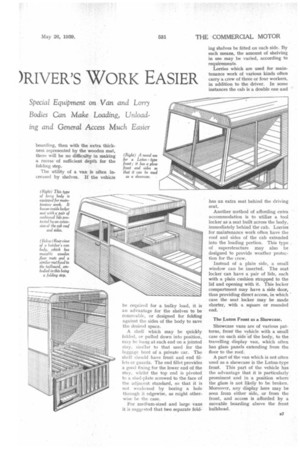Go ids-body Features Which MAKE THE )RIVER'S WORK EASIER
Page 40

Page 41

If you've noticed an error in this article please click here to report it so we can fix it.
Special Equipment on Van and Lorry Bodies Can Make Loading, Unloading and General Access Much Easier MANY vans have more than 6 ft. of headroom and the overall height of the vehicle depends on that of the chassis and whether the floor be close to the chassis, or above the rear wheels. There are occasions when it would be an advantage if the headroom could be temporarily reduced, such as ;glen a delivery has to be made through a low archway. If the vehicle be too high for the archway, much time is lost because goods have to be unloaded in the street and carried by. hand, or transported by truck.
Sometimes the usual light and bulky load is replaced by a heavy and concentrated one. If the headroom can be reduced, then there is a saving in wind resistance. Also, a vehicle which is adjustable for height, when being garaged away from home, can often be accommodated in premises which could not be utilized if the superstructure were a fixture.
The type of van which is most suitable for varying the headroom, is the van which has a waterproof sheet, supported on hoops. The feet, of the hoops are held in outside staples, as with the ordinary sheeted van. In order to facilitate the lowering of the hoops, their feet are connected by a rail. This rail holds the hoops in position, because it has thumbscrews which register with tapped plates in the body sides: When the screws are unfastened, the hoops are lowered by means of the rail, and they are controlled by vertical guides. The maximum adjustment of the hoops is determined by an inside rail, which rests on the body side when the hoops are at their lowest position. Then the thumbscrews are inserted in the lower set of tapped plates provided.
With a modification in the design of the fittings, it would be possible to provide adjustable headroom for a boarded tilt, or a panelled top if the vehicle concerned had only a tailboard at the back, Making Provision for a Step.
When the floor at the back of the van is not easily reached from the ground level, a step is useful, but if there be a tailboard then the step should be attached to it. A step which folds flush is most suitable, and may be similar to that used on coaches for mounting to the roof. Alternatively, a larger design may be fitted. The step should be placed close to one side of the van so that, with an ascending handle fastened to the adjacent. corner. pillar, entry is made easy.
When the butcher's market van is equipped with a tailboard step, a framework of battens may be added to the inside of the tailboard, so that it has a fixed wooden mat, similar to the removable ones on the floor. If the tailboard be framed and panelled, or be made of two thicknesses of
boarding, then with the extra thickness represented by the wooden mat, there will be no difficulty in making a recess of sufficient depth for the folding step.
The utility of a van is often increased by shelves. If the vehicle
be required for a bulky load, it is an advantage for the shelves to be removable, or designed for folding against the sides of the body to save the desired space.
A shelf which may be quickly folded, or pulled down into position, may be hung at each end on a jointed stay, similar to that used for the luggage boot of a private car. The shelf should have front and end fillets or guards. The end fillet provides a good fixing for the lower end of the stay, whilst the top end is pivoted to a stud-plate screwed to the face of the adjacent standard, so that it is not weakened by boring a hole through it edgewise, as might otherwise be the case.
For medium-sized and large vans it is suggested that two separate fold
ing shelves be fitted on each side. By such means, the amount of shelving in use may be varied, according to requirements.
Lorries which are used for maintenance work of various kinds often carry a crew of three or four workers, in addition to the driver. In some instances the cab is a double one and has an extra seat behind the driving seat.
Another method of affording extra accommodation is to utilize a tool locker as a seat built across the body, immediately behind the cab. Lorries for maintenance work often have the roof and sides of the cab extended into the loading portion. This type of superstructure may also be designed to provide weather protection for the crew.
Instead of a plain side, a small window can be inserted. The seat locker can have a pair of lids, each with a plain cushion strapped to the lid and opening with it. This locker compartment may have a side door, thus providing direct access, in which case the seat locker may be made shorter, with a square or rounded end.
The Luton Front as a Showcase.
Showcase vans are of various patterns, from the vehicle with a small case on each side of the body, to the travelling display van, which often has glass panels extending from the floor to the roof.
A part of the van which is not often used as a showcase is the Luton-type front. This part of the vehicle has the advantage that it is particularly prominent and in a position where the glass is not likely to be broken. Moreover, any display here may be seen from either side, or from the front, and access is afforded by a movable boarding above the front bulkhead.




















































































